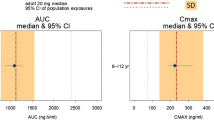Abstract
A population pharmacokinetic analysis was conducted to characterize the pharmacokinetics of fexofenadine in Japanese pediatric patients (6 months through 16 years) with perennial allergic rhinitis or atopic dermatitis. The dataset was composed of 515 patients (including 109 adults), for a total of 1,080 concentration–time points. The analysis was performed with NONMEM using the SAEM method. Several structural models and residual error models were evaluated. The relationship between the individual estimates and the potential covariates was then investigated: demographic and pathophysiologic characteristics were tested as potential model covariates (forward selection method). The qualification of the model was performed using visual predictive check and bootstrap. A two-compartment disposition model with first-order absorption best fitted the data. The inter-individual variability was modeled through an exponential error model for all parameters (except for ka for which no inter-individual term could be estimated), while a proportional error model was used to model the residual variability. The final model included two covariates on elimination clearance and one on the intercompartmental clearance. CL/F was related to BSA and patient’s age (expressed in months) Q/F was also related to BSA. Once the model was correctly qualified, exposure parameters such as Cmax and AUCτ were computed and compared between each age sub-group and between Japanese and Caucasians patients. These comparisons did not reveal any major difference (less than 50 %) between subgroups.


Similar content being viewed by others
References
Devillier P, Roche N, Faisy C (2008) Clinical pharmacokinetics and pharmacodynamic of desloratadine, fexofenadine and levocetirizine. Clin Pharmacokinet 47:217–230
Lappin G, Shishikura Y, Jochemsen R, Weaver RJ, Gesson C, Houston B, Oosterhuis B, Bjerrum OJ, Rowland M, Garnier C (2010) Pharmacokinetics of fexofenadine: evaluation of a microdose and assessment of absolute oral bioavailability. Eur J Pharm Sci 40(2):125–131
Krishna R, Krishnaswami S, Kittner B et al (2004) The utility of mixed-effects covariate analysis in rapid selection of doses in pediatric subjects: a case study with fexofenadine hydrochloride. Biopharm Drug Dispos 25:373–387
Beal S, Sheiner LB, Boeckmann A, Bauer RJ (2009) NONMEM user’s guides. Icon Development Solutions, Manchester
Speth H (2004) A Linux cluster for population pharmacokinetic analyses. Internat J Clin Pharm Ther 42:189–190
Holford NH (1996) A size standard for pharmacokinetics. Clin Pharmacokinet 30:329–332
Tod M, Jullien V, Pons G (2008) Facilitation of drug evaluation in children by population methods and modelling. Clin Pharmacokinet 47:231–243
Holford N (2010) Dosing in children. Clin Pharmacol Ther 87:367–370
Parke J, Holford NHG, Charles BG (1999) A procedure for generating bootstrap samples for the validation of nonlinear mixed-effects population models. Comput Methods Prog Biomed 59:19–29
Yano Y, Beal SL, Sheiner LB (2001) Evaluating pharmacokinetic/pharmacodynamic models using the posterior predictive check. J Pharmacokinet Pharmacodyn 28(2):171–192
Bergstrand M, Hoocker AC, Walling JE, Karlsson MO (2011) Prediction-corrected visual predictive checks for diagnosing nonlinear mixed-effects models. AAPS J 13:143–151
DuBois D, DuBois EF (1916) A formula to estimate the approximate surface area if height and weight be known. Arch Int Med 17:863–871
Acknowledgments
The authors acknowledge Pascale Boittet, Guilhem Darche, Nassim Djebli, Isabelle Pouget, Heiner Speth and Yoshiharu Takagi for their contribution to this work.
Conflict of interest
All the authors except Sonia Khier are Sanofi employees.
Author information
Authors and Affiliations
Corresponding author
Electronic supplementary material
Below is the link to the electronic supplementary material.
Fig. 1
Relationship between individual CL/F values and covariates retained in the model. Supplementary material 1 (EPS 5957 kb)
Rights and permissions
About this article
Cite this article
Martinez, JM., Khier, S., Morita, S. et al. Population pharmacokinetic analysis of fexofenadine in Japanese pediatric patients. J Pharmacokinet Pharmacodyn 41, 187–195 (2014). https://doi.org/10.1007/s10928-014-9356-2
Received:
Accepted:
Published:
Issue Date:
DOI: https://doi.org/10.1007/s10928-014-9356-2




